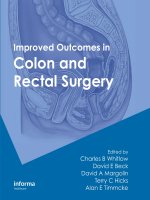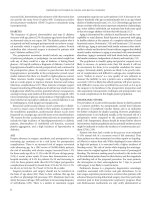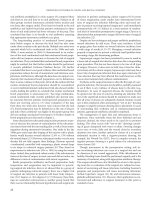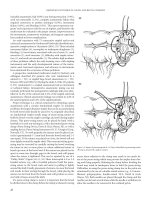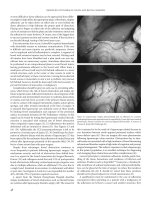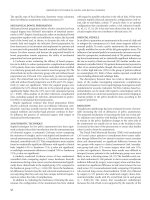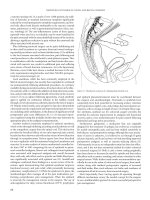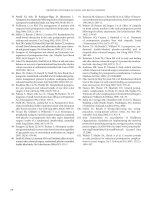Improved Outcomes in Colon and Rectal Surgery part 3 pptx
Bạn đang xem bản rút gọn của tài liệu. Xem và tải ngay bản đầy đủ của tài liệu tại đây (135.87 KB, 10 trang )
improved outcomes in colon and rectal surgery
increased risk. Intermittent pulse oximetry with observation does
not provide the same level of safety.(100) Continuous positive
airway pressure ventilation (CPAP) is given to all patients using
it preoperatively.
diabetes
The frequency of glucose abnormalities and type II diabetes
increases with age; almost 25% of patients aged more than 60 had
an abnormal value in one report.(66) The diabetic patient who is
recognized and well managed perioperatively can achieve a surgi-
cal mortality which is equal to the nondiabetic patient. Protein
catabolism after colorectal surgery is increased in patients with
type 2 diabetes mellitus.(101)
The preoperative assessment should include any complaints
of polyuria, polydypsia, or polyphagia. An associated weight loss
with any of these could be a sign of diabetes. A fasting blood
glucose >140 mg/dl confirms a diagnosis of diabetes. Control of
hyperglycemia should be started preoperatively and continued in
the postoperative phase. In contrast to past doctrine that mild
hyperglycemia is permissible in the perioperative period, newer
studies indicate that there is a benefit in tighter glucose control.
These intensive insulin strategies result in less hyperglycemia
and as a result appear to improve immune function and reduce
infectious complications.(102) These intensive strategies require
frequent monitoring of blood glucose levels but may result in more
hypoglycemia which has serious potential adverse consequences,
causing two large scale studies of this method to be stopped.(103)
Close monitoring of glucose and avoidance of hyperglycemia has
clear benefit, but especially in difficult-to-control diabetics it can
be challenging to avoid dangerous hypoglycemia.
Renal and cardiovascular disease occurs commonly in diabet-
ics and is a major cause of death in these patients. Compared to
the nondiabetic population, cardiovascular disease occurs more
frequently at a younger age, and with more severe manifestations.
The reasons for this accelerated atherosclerosis are postulated to
include the high incidence of hyperlipoproteinemia in diabetic
patients, abnormalities of endothelial cell function, increased
platelet aggregation, and a high incidence of hypertension in
diabetics.
age
Despite advances in surgery, anesthesia, and perioperative care,
increasing age continues to be a risk factor for perioperative
complications. There is an increased risk of surgery associated
with advancing age. In a 1982 review of 50,000 elderly patients,
the risk of mortality with elective surgery increased from 1.3%
for those under age 60, to 11.3% in the 80–89 year-old age group.
(104) A recent review nearly 20 years later demonstrates an in-
hospital mortality of 0.3% for patients 50–59 and increasing to
2.6% for those patients older than 80.(105) Major perioperative
complications increased by decade from 4.3% for 50–59, to 5.7%
for 60–69, to 9.6% for 70–79 and 12.5% for 80 or older.
Surgical procedures and surgery should not be restricted on
the basis of age alone.(106) There is clear evidence that age has
an effect on physiologic life processes.(107) Maximum heart rate
slowly decreases with age (108) and there is an increasing frequency
of arrhythmias (109). There is a decline in maximum oxygen
consumption except in very active patients.(110) A decrease in ven-
tilatory threshold with age is predominantly due to an age-related
decline of skeletal muscle mass.(111, 112) Chronologic age does not
always correlate with the more important estimation of physiologic
age. Active athletic individuals can maintain lean body mass equal
to that of younger athletes well into their 8th decade.(113)
Aging is characterized by a decline in renal function and by a sus-
ceptibility to renal diseases. Renal function is preserved with aging
in healthy subjects at the expense of a complete reduction of renal
functional reserve. Proteinuria (114) and bacteriuria (115) increase
with the age. Aging is associated with insulin resistance often attrib-
utable to obesity and inactivity. Recent evidence suggests that skeletal
muscle insulin resistance in aging is associated with mitochondrial
alterations. Aging is associated with both whole body and myocar-
dial insulin resistance, independent of obesity and inactivity.(113)
The population is steadily aging and geriatric surgical care is
likely to increase. As patients enter their 9th decade it will not
be uncommon for them to be acceptable candidates for major
surgery. Extremely elderly patients are likely to be poorly toler-
ant of complications and difficult to salvage once complications
occur. “Failure to rescue” is a new quality of care indicator to
measure the inability to save a patient once a complication has
occurred.(116) It is likely that elderly patients will prove particu-
larly difficult to rescue once a problem has occurred, so it is up to
the surgeon to be fastidious in his preoperative preparation and
risk assessment, intraoperative technique and postoperative care
to avoid complications in this fragile patient population.
neurologic system
The prevalence of occult cerebrovascular disease in elderly patients
is a common problem. An asymptomatic carotid bruit indicates
the presence of peripheral vascular disease and is an indication
for further evaluation by duplex scanning. However, prophylactic
endarterectomy is not indicated usually, as the increased risk of a
perioperative stroke compared to the unselected population is
small.(118) Symptomatic disease should be treated before elective
interventions. Aspirin prophylaxis and occasionally endarterectomy
might be indicated to reduce the incidence of cerebrovascular acci-
dents (CVA).(119)
Patients who have had a stroke in the past are at an estimated
5–15% annual risk of a recurrent event if left untreated. Thus
these patients are often maintained on either aspirin or clopidog-
rel (Plavix) to reduce their risk. While clopidogrel is more effective
in high-risk patients, it is associated with a higher incidence of
bleeding events. The risk of stroke while stopping the anticoagu-
lation must be weighed against the adverse event of postsurgical
bleeding. The decision-making must be tailored to the stroke risk
of the individual patient based on their history and the magnitude
and bleeding risk of the proposed procedure. For most patients,
the interruption in their anticoagulation for 7 days to proceed
with surgery is not likely to result in harm.
Parkinson’s disease is a progressive degenerative neurologic
condition associated with tremor and gait disturbance. In its
later stages, aspiration pneumonia is common thus patients with
advanced disease having abdominal surgery must have particular
attention paid to their postoperative respiratory program. Most
anti-Parkinsonian medications are only orally administered so
preexisting conditions
they must be withheld after abdominal surgery until oral medi-
cations can be given. This can result in rigidity and further wors-
ening of airway protection. One author describes use of rectally
administered domperidone to patients with Parkinson’s disease
having abdominal surgery in an effort to avoid such problems.
(120) We have little experience with this, but it may prove useful
in a particularly symptomatic patient.
hyPerCOAgUAble dISOrderS
Management of patients with hypercoaguable syndromes can
be especially challenging in the setting where the need to con-
trol postoperative bleeding is crucial. Common (factor V Leiden
deficiency) and relatively uncommon (antithrombin deficiency,
protein C and protein S deficiency) causes of thrombosis have
different risk associations. For example, the relative risk of venous
thrombosis in the Caucasian population can range from 2.5%
for the prothrombin gene mutation to 25% in the presence of
antithrombin deficiency.(121) Furthermore, approximately 50%
of cases of venous thrombosis associated with these hereditary
disorders are provoked by known risk factors such as surgery.
Therefore, aggressive prophylaxis with subcutaneous heparin or
low-molecular heparin is warranted peri- and postoperatively.
By contrast, for those on long-term anticoagulation, the decision
to continue treatment for thrombosis should be individualized.
In general, warfarin therapy can be switched to low-molecular
weight or intravenous heparin 3 to 5 days before surgery.(121)
Patients with antiphospholipid antibody syndrome (lupus anti-
coagulant/anticardiolipin antibodies, history of arterial or venous
thrombosis, and/or recurrent fetal loss) deserve special mention.
Currently available anticoagulants are effective in reducing the
recurrence rate of venous thromboembolism (VTE). VTE is a
common complication in cancer patients and can lead to delay in
cancer therapy and is predictive of a worse prognosis. Prophylaxis
with anticoagulants is recommended for patients hospitalized for
surgery or medical conditions, but is not routinely administered
in the ambulatory setting.(122) However, anticoagulant treatment
is associated with an increased risk for bleeding complications and
needs to be discontinued when benefit of treatment no longer
clearly outweigh its risks.(123) The incidence of recurrent VTE
can be estimated through a two-step decision algorithm. First, the
features of the patient (gender), of the initial event (proximal or
distal deep vein thrombosis or pulmonary embolism), and the
associated conditions (cancer, surgery, etc) provide essential infor-
mation on the risk for recurrence after anticoagulant treatment
discontinuation. Second, at time of anticoagulant treatment dis-
continuation, D-dimer levels and residual thrombosis have been
indicated as predictors of recurrent VTE. Current evidence sug-
gests that the risk of recurrence after stopping therapy is largely
determined by whether the acute episode of VTE has been effec-
tively treated and by the patient’s intrinsic risk of having a new
episode of VTE. All patients with acute VTE should receive oral
anticoagulant treatment for 3 months. At the end of this treat-
ment period, physicians should decide for withdrawal or indefi-
nite anticoagulation. Based on intrinsic patient’s risk for recurrent
VTE and for bleeding complications and on patient preference,
selected patients could be allocated to indefinite treatment with
scheduled periodic reassessment of the benefit from extending
anticoagulation. Cancer patients should receive low-molecular
weight heparin over warfarin in the long-term treatment of VTE.
These patients should be considered for extended anticoagulation
at least until resolution of underlying disease.(123)
conclusion
The history and physical examination is the most important part
of the preoperative evaluation and can be used to guide further
workup and testing. Multiple scoring systems are available to
quantify risk of postoperative complications and mortality based
on preoperative conditions. Optimization of these conditions
will increase the likelihood of a successful outcome.
references
1. Wilson ME, NB WI, Baskett PJ, Bennett JA, Skene AM.
Assessment of fitness for surgical procedures and the vari-
ability of anesthetists’’ judgments. Br Med J 1980; 280(6213):
509–12.
2. Parker BM, Tetzlaff JE, Litaker DL, Maurer WG. Redefining
the preoperative evaluation process and the role of the anes-
thesiologist. J Clin Anesth 2000; 12(5): 350–6.
3. Arvidsson S OJ, Sjostedt L, Svardsudd. Predicting postop-
erative adverse events. Clinical efficiency of four general
classification systems. The project perioperative risk. Acta
Anaesthesiol Scand 1996; 40(7): 783–91.
4. Roizen MF. The surgical burden: how to prevent a crisis in
perioperative medicine. Cleve Clin J Med 2006; 73(Suppl 1):
S8–12.
5. Mancuso CA. Impact of new guidelines on physicians’
ordering of preoperative tests. J Gen Intern Med 1999;
14(3): 166–72.
6. Greer AE, Irwin MG. Implementation and evaluation of
guidelines for preoperative testing in a tertiary hospital.
Anaesth Intensive Care 2002; 30(3): 326–30.
7. Roizen M. Preoperative patient evaluation. Can J Anaesth
1989; 36: S13–9.
8. Kaplan EB, Sheiner LB, Boeckmann AJ et al. The usefulness
of preoperative laboratory screening. JAMA 1985; 253(24):
3576–81.
9. Carson JL, Duff A, Poses RM et al. Effect of anaemia and
cardiovascular disease on surgical mortality and morbidity.
Lancet 1996; 348(9034): 1055–611.
10. Bushick JB, Eisenberg JM, Kinman J, Cebul RD, Schwartz JS.
Pursuit of abnormal coagulation screening tests generates
modest hidden preoperative costs. J Gen Intern Med 1989;
4(6): 493–7.
11. Delaney CP, McKeigan J. Pre-operative management –
bowel preparation, medical evaluation. ASCRS Textbook of
Colorectal Surgery, eds. Fleshman, Beck, Wolff, Pemberton,
Wexner. Springer Verlag, New York, NY, 2006.
12. Arvidsson S, Ouchterlony J, Sjostedt L, Svardsudd K.
Predicting postoperative adverse events. Clinical efficiency
of four general classification systems. The project periop-
erative risk. Acta Anaesthesiol Scand 1996; 40(7): 783–91.
13. Klotz HP, Candinas D, Platz A et al. Preoperative risk assess-
ment in elective general surgery. Br J Surg 1996; 83(12):
1788–91.
improved outcomes in colon and rectal surgery
14. Hartley MN, Sagar PM. The surgeon's 'gut feeling' as a
predictor of post-operative outcome. Ann R Coll Surg Engl
1994; 76(6 Suppl): 277–8.
15. Kiran RP, Delaney CP, Senagore AJ. “Peri-operative
Management.” Preoperative evaluation and risk assessment
scoring. Clinics in Colorectal Surgery 2003; 16(2): 75–84.
16. Keats AS. The ASA classification of physical status–a reca-
pitulation. Anesthesiology 1978; 49(4): 233–6.
17. Vacanti CJ, VanHouten RJ, Hill RC. A statistical analysis of
the relationship of physical status to postoperative mortality
in 68,388 cases. Anesth Analg 1970; 49(4): 564–6.
18. Menke H, Klein A, John KD, Junginger T. Predictive value
of ASA classification for the assessment of the perioperative
risk. Int Surg 1993; 78(3): 266–70.
19. Owens WD, Dykes MH, Gilbert JP, McPeek B, Ettling MB.
Development of two indices of postoperative morbidity.
Surgery 1975; 77(4): 586–92.
20. Wolters U, Wolf T, Stutzer H, Schroder T. ASA classification
and perioperative variables as predictors of postoperative
outcome. Br J Anaesth 1996; 77(2): 217–22.
21. Copeland GP, Jones D, Walters M. POSSUM: a scoring
system for surgical audit. Br J Surg 1991; 78(3): 355–60.
22. Bennett-Guerrero E, Hyam JA, Shaefi S et al. Comparison
of P-POSSUM risk-adjusted mortality rates after surgery
between patients in the USA and the UK. Br J Surg 2003;
90(12): 1593–8.
23. Prytherch DR, Whiteley MS, Higgins B et al. POSSUM
and Portsmouth POSSUM for predicting mortality.
Physiological and Operative Severity Score for the enU-
meration of Mortality and morbidity. Br J Surg 1998; 85(9):
1217–20.
24. Wijesinghe LD, Mahmood T, Scott DJ et al. Comparison
of POSSUM and the Portsmouth predictor equation for
predicting death following vascular surgery. Br J Surg 1998;
85(2): 209–12.
25. Kuhan G, Abidia AF, Wijesinghe LD et al. POSSUM and
P-POSSUM overpredict mortality for carotid endarterectomy.
Eur J Vasc Endovasc Surg 2002; 23(3): 209–11.
26. Midwinter MJ, Tytherleigh M, Ashley S. Estimation of
mortality and morbidity risk in vascular surgery using
POSSUM and the Portsmouth predictor equation. Br J Surg
1999; 86(4): 471–4.
27. Tekkis PP, Kocher HM, Bentley AJ et al. Operative mortality
rates among surgeons: comparison of POSSUM and p-POS-
SUM scoring systems in gastrointestinal surgery. Diseases of
the colon and rectum 2000; 43(11): 1528–32.
28. Senagore AJ, Delaney CP, Duepree HJ, Brady KM, Fazio VW.
Evaluation of POSSUM and P-POSSUM scoring systems in
assessing outcome after laparoscopic colectomy. Br J Surg
2003; 90(10): 1280–4.
29. Tekkis PP, Prytherch DR, Kocher HM et al. Development
of a dedicated risk-adjustment scoring system for colorec-
tal surgery (colorectal POSSUM). Br J Surg 2004; 91(9):
1174–82.
30. Law WL, Lam CM, Lee YM. Evaluation of outcome of lap-
aroscopic colorectal resection with POSSUM, Portsmouth
POSSUM and colorectal POSSUM. Br J Surg 2006; 93(1):
94–9.
31. Senagore AJ, Warmuth AJ, Delaney CP, Tekkis PP, Fazio VW.
POSSUM, P-POSSUM, CR-POSSUM: implementation
issues in a United States health care system for prediction
of outcome for colon cancer resection. Dis Colon Rectum
2004; 47(9): 1435–41.
32. Khuri S, Daley J, Henderson W et al. The national veterans
administration surgical risk study: risk adjustment for the
comparative assessment of the quality of surgical care. J Am
Coll Surg 2005; 180: 519–531.
33. Khuri S, Daley J, Henderson W. The comparative assess-
ment and improvement of quality of surgical care in the
Department of Veterans Affairs. Arch Surg 2002; 137: 20–27.
34. Longo WE, Virgo KS, Johnson FE et al. Risk factors for mor-
bidity and mortality after colectomy for colon cancer. Dis
Colon Rectum 2000; 43: 83–91.
35. Poldermans D, Boersma E, Bax JJ et al. The effect of biso-
prolol on perioperative mortality and myocardial infarction
in high-risk patients undergoing vascular surgery. N Engl
J Med 1999; 341: 1789–94.
36. Goldman L, Caldera DL, Nussbaum SR et al. Multifactorial
index of cardiac risk in noncardiac surgical procedures.
N Engl J Med 1977; 297(16): 845–50.
37. Detsky AS, Abrams HB, McLaughlin JR et al. Predicting
cardiac complications in patients undergoing non-cardiac
surgery. J Gen Intern Med 1986; 1: 211–9.
38. Lee TH, Marcantonio ER, Mangione CM et al. Derivation
and prospective validation of a simple index for prediction
of cardiac risk of major noncardiac surgery. Circulation
1999; 100: 1043–9.
39. Fleisher LA, Beckman JA, Freeman WK et al. ACC/AHA 2006
guideline update on perioperative cardiovascular evaluation
on noncardiac surgery: focused update on perioperative
beta-blocker therapy. J Am Coll Cardiol 2006; 47: 1–12.
40. Weksler N, Klein M, Szendro G et al. The dilemma of imme-
diate preoperative hypertension: to treat and operate, or to
postpone surgery? J Clin Anesth 2003; 15: 179–83.
41. Hlatky MA, Boineau RE, Higginbotham MB et al. A brief
self-administered questionnaire to determine functional
capacity (the Duke Activity Status Index). Am J Cardiol
1989; 64(10): 651–4.
42. Goldberger AL, O’Konski M. Utility of the routine electro-
cardiogram before surgery and on general hospital admis-
sion. Critical review and new guidelines. Ann Intern Med
1986; 105(4): 552–7.
43. Liu LL, Dzankic S, Leung JM. Preoperative electrocardio-
gram abnormalities do not predict postoperative cardiac
complications in geriatric surgical patients. J Am Geriatr Soc
2002; 50(7): 1186–91.
44. Tait AR, Parr HG, Tremper KK. Evaluation of the efficacy
of routine preoperative electrocardiograms. J Cardiothorac
Vasc Anesth 1997; 11(6): 752–5.
45. Noordzij PG, Boersma E, Bax JJ et al. Prognostic value of rou-
tine preoperative electrocardiography in patients undergoing
noncardiac surgery. Am J Cardiol 2006; 97(7): 1103–6.
preexisting conditions
46. van Klei WA, Bryson GL, Yang H et al. The value of routine pre-
operative electrocardiography in predicting myocardial infarc-
tion after noncardiac surgery. Ann Surg 2007; 246(2): 165–70.
47. Kannel WB, Abbott RD. Incidence and prognosis of unrecog-
nized myocardial infarction. An update on the Framingham
study. N Engl J Med 1984; 311(18): 1144–7.
48. Velanovich V. Preoperative screening electrocardiography:
predictive value for postoperative cardiac complications.
South Med J 1994; 87(4): 431–4.
49. McFalls EO, Ward HB, Moritz TE et al. Coronary-artery
revascularization before elective major vascular surgery.
N Eng J Med 2004; 351: 2795–804.
50. Poldermans D, Schouten O, Vidakovic R et al. A clinical
randomized trial to evaluate the safety of a noninvasive
approach in high-risk patients undergoing major vascular
surgery: the DECREASE-V Pilot Study. J Am Coll Cardiol
2007; 49: 1763–9.
51. Poldermans D, Bax JJ, Schouten O et al. Should major vas-
cular surgery be delayed because of preoperative cardiac
testing in intermediate-risk patients receiving beta-blocker
therapy with tight heart rate control? J Am Coll Cardiol
2006; 48: 964–9.
52. Hindler K, Shaw AD, Samuels J et al. Improved postopera-
tive outcomes associated with preoperative statin therapy.
Anesthesiology 2006; 105: 1260–72.
53. Smetana GW, Lawrence VA, Cornell JE. Preoperative pul-
monary risk stratification for noncardiothoracic surgery:
systematic review for the American College of Physicians.
Ann Int Med 2006; 144: 581–95.
54. Arozullah AM, Daley J, Henderson WG, Khuri SF.
Multifactorial risk index for predicting postoperative respi-
ratory failure in men after major noncardiac surgery. Ann
Surg 2000; 232: 242–53.
55. Smetana GW, Macpherson DS. The case against routine
preoperative laboratory testing. Med Clin North Am 2003;
87: 7–40.
56. Archer C, Levy AR, McGregor M. Value of routine preoperative
chest x-rays: a meta-analysis. Can J Anesth 1993; 40: 1022–7.
57. Kroenke K, Lawrence VA, Theroux JF, Tuley MR. Operative
risk in patients with severe obstructive pulmonary disease.
Arch Intern med 1992; 152: 967–71.
58. Lawrence VA, Cornell JE, Smetana GW. Strategies to reduce
postoperative pulmonary complications after noncardio-
thoracic surgery: systematic review for the American College
of Physicians. Ann Intern Med 2006; 144(8): 596–608.
59. Nakagawa M, Tanaka H, Tsukauma H, Kishi Y. Relationship
between the duration of the preoperative smoke-free
period and the incidence of postoperative pulmonary com-
plications after pulmonary surgery. Chest 2001; 120(3):
705–10.
60. Bluman LG, Mosca L, Newman N, Simon D. Preoperative
smoking habits and postoperative pulmonary complica-
tions. Chest 1998; 113: 883–9.
61. Barrera R, Shi W, Amar D et al. Smoking and Timing of
Cessation: impact on pulmonary complications after thora-
cotomy. Chest 2005; 127: 1977–83.
62. Abraham NS, Young J, Solomon M. Meta-analysis of short-
term outcomes after laparoscopic resection for colorectal
cancer. Br J Surg 2004; 91: 1111–24.
63. National asthma education and prevention program expert
panel report: guidelines for the diagnosis and management
of asthma update on selected topics-2002. J Allergy Clin
Immunol 2002; 110: S141–219.
64. Lawrence VA, Kroenke K. The unproven utility of preopera-
tive urinalysis. Clinical use. Arch Intern Med 1988; 148(6):
1370–3.
65. Hricik DE, Browning PJ, Kopelman R. Captopril-induced
functional renal insufficiency in patients with bilateral
renal-artery stenoses or renal-artery stenosis in a solitary
kidney. N Engl J Med 1983; 308(7): 373–6.
66. Velanovich V. Preoperative laboratory screening based on
age, gender, and concomitant medical diseases. Surgery
1994; 115(1): 56–61.
67. Chertow GM, Lazarus JM, Christiansen CL et al. Preoperative
renal risk stratification. Circulation 1997; 95(4): 878–84.
68. Gailiunas P Jr, Chawla R, Lazarus JM et al. Acute renal fail-
ure following cardiac operations. J Thorac Cardiovasc Surg
1980; 79(2): 241–3.
69. Abrahamov D, Tamariz M, Fremes S et al. Renal dysfunction
after cardiac surgery. Can J Cardiol 2001; 17(5): 565–70.
70. Krysa J, Patel V, Taylor J et al. Outcome of patients on
renal replacement therapy after colorectal surgery. Dis Col
Rectum 2008; 51(6): 961–5.
71. Touraine JL, Touraine F, Revillard JP, Brochier J, Traeger
J. T-lymphocytes and serum inhibitors of cell-mediated immu-
nity in renal insufficiency. Nephron 1975; 14(2): 195–208.
72. Bleyl U, Sander E, Schindler T. The pathology and biology
of uremic pneumonitis. J Intensive Care Med 1981; 7(4):
193–202.
73. Adams PL, Rutsky EA, Rostand SG, Han SY. Lower gastro-
intestinal tract dysfunction in patients receiving long-term
hemodialysis. Archives of internal medicine 1982; 142(2):
303–6.
74. Garrison RN, Cryer HM, Howard DA, Polk HC. Clarification
of risk factors for abdominal operations in patients with
hepatic cirrhosis. Ann Surg 1984; 199(6): 648–54.
75. Metcalf AM, Dozois RR, Wolff BG, Beart RW Jr. The surgi-
cal risk of colectomy in patients with cirrhosis. Dis Colon
Rectum 1987; 30(7): 529–31.
76. Narr BJ, Hansen TR, Warner MA. Preoperative laboratory
screening in healthy Mayo patients: cost-effective elimi-
nation of tests and unchanged outcomes. Mayo Clin Proc
1991; 66(2): 155–9.
77. Smetana GW, Macpherson DS. The case against routine
preoperative laboratory testing. Med Clin North Am 2003;
87(1): 7–40.
78. Powell-Jackson P, Greenway B, Williams R. Adverse effects
of exploratory laparotomy in patients with unsuspected
liver disease. Br J Surg 1982; 69(8): 449–51.
79. Suchman AL, Mushlin AI. How well does the activated par-
tial thromboplastin time predict postoperative hemorrhage?
JAMA 1986; 256(6): 750–3.
improved outcomes in colon and rectal surgery
80. Campos AC, Meguid MM. A critical appraisal of the useful-
ness of perioperative nutritional support. Am J Clin Nutr
1992; 55(1): 117–30.
81. Thompson BR, Julian TB, Stremple JF. Perioperative total
parenteral nutrition in patients with gastrointestinal cancer.
J Surg Res 1981; 30(5): 497–500.
82. Vitello JM. Nutritional assessment and the role of preopera-
tive parenteral nutrition in the colon cancer patient. Semin
Surg Oncol 1994; 10(3): 183–94.
83. Cook JW, Pierson LM, Herbert WG et al. The influence
of patient strength, aerobic capacity and body composi-
tion upon outcomes after coronary artery bypass grafting.
Thorac Cardiovasc Surg 2001; 49(2): 89–93.
84. Engelman DT, Adams DH, Byrne JG et al. Impact of body
mass index and albumin on morbidity and mortality after
cardiac surgery. J Thorac Cardiovasc Surg 1999; 118(5):
866–73.
85. Rosen FS, Cooper MD, Wedgwood RJ. The primary immu-
nodeficiencies. (2). N Engl J Med 1984; 311(5): 300–10.
86. Morstyn G, Campbell L, Souza LM et al. Effect of granulo-
cyte colony stimulating factor on neutropenia induced by
cytotoxic chemotherapy. Lancet 1988; 1(8587): 667–72.
87. Bronchud M, Scarffe JH, Thatcher N et al. Phase I/II study
of recombinant human granulocyte colony-stimulating fac-
tor in patients receiving intensive chemotherapy for small
cell lung cancer. Behring Inst Mitt 1988; 83: 327–9.
88. Cook EJ, Walsh SR, Farooq N et al. Post-operative neutro-
phil-lymphocyte ratio predicts complications following
colorectal surgery. Int J Surg (London, England) 2007; 5(1):
27–30.
89. Barrett WL, Callahan TD, Orkin BA. Perianal manifesta-
tions of human immunodificiency virus infection: expe-
rience with 260 patients. Dis Colon Rectum 1998; 41(5):
606–12.
90. Friedman JE, Dallal RM, Lord JL. Gouty attacks occur
frequently in postoperative gastric bypass patients. Surg
Obes Relat Dis 2008; 4(1): 11–3.
91. Craig MH, Poole GV, Hauser CJ. Postsurgical gout. Am Surg
1995; 61(1): 56–9.
92. Wyngaarden JB. Gout. Philadelphia: Saunders; 1992.
93. Dindo D, Muller MK, Weber M, Clavien PA. Obesity in
general elective surgery. Lancet 2003; 361: 2032–5.
94. Riou JP, Choen JR, Johnson H. Factors affecting wound
dehiscence. Am J Surgery 1992; 163: 324–30.
95. Sugerman HJ, Kellum JM, Reines D et al. Greater risk of
incisional hernia with morbidly obese than steroid-depen-
dent patients and low recurrence with incisional prefascial
polypropylene mesh. Am J Surg 1996; 171: 80–4.
96. Arumugam PJ, Bevan L, Macdonald L et al. A prospective
audit of stomas: analysis of risk factors and complications
and their management. Colorectal Dis 2003; 5: 49–52.
97. Rullier R, Laurent C, Garrelon JL et al. Risk factors for anas-
tamotic leakage after resection of rectal cancer. Br J Surg
1998; 85: 355–8.
98. Gendall KA, Raniga S, Kennedy R, Frizelle FA. The impact
of obesity on outcome after major colorectal surgery. Dis
Colon Rectum 2007; 2223–37.
99. Tekkis PP, Senagore AJ, Delaney CP, Fazio VW. Evaluation
of the learning curve in laparoscopic colorectal surgery:
comparison of right-sided and left-sided resections. Ann
Surg 2005; 242: 83–91.
100. Practice guidelines for the perioperative management
of patients with obstructive sleep apnea: a report by the
American Society of anesthesiologists task force on peri-
operative management of patients with obstructive sleep
apnea. Anesthesiology 2006; 104(5): 1081–93.
101. Schricker T, Gougeon R, Eberhart L et al. Type 2 diabetes mel-
litus and the catabolic response to surgery. Anesthesiology
2005; 102(2): 320–6.
102. Van den Berghe G, Wouters P, Weekers F et al. Intensive
insulin therapy in critically ill patients. NEJM 2001; 345:
1359–67.
103. Blondet JJ, Beilman GJ. Glycemic control and prevention of
postoperative infection. Curr Opin Crit Care 2007; 13(4):
421–7.
104. Linn BS, Linn MW, Wallen N. Evaluation of results of surgi-
cal procedures in the elderly. Annals of surgery 1982; 195(1):
90–6.
105. Polanczyk C, Marcantonio E, Goldman L et al. Impact of
age on perioperative complications and length of stay in
patients undergoing noncardiac surgery. Ann Int Med 2001;
134(8): 637–42.
106. Faivre J, Lemmens VE, Quipourt V, Bouvier AM.
Management and survival of colorectal cancer in the elderly
in population-based studies. Eur J Cancer 2007; 43(15):
2279–84.
107. Leach RE. Aging and physical activity. Der Orthopade 2000;
29(11): 936–40.
108. Helwig BG, Parimi S, Ganta CK et al. Aging alters regula-
tion of visceral sympathetic nerve responses to acute hypo-
thermia. Am J Physiol 2006; 291(3): R573–9.
109. Moller CS, Haggstrom J, Zethelius B et al. Age and follow-
up time affect the prognostic value of the ECG and conven-
tional cardiovascular risk factors for stroke in adult men.
J Epidemiol Community Health 2007; 61(8): 704–12.
110. Bogaard HJ, Woltjer HH, Dekker BM et al. Haemodynamic
response to exercise in healthy young and elderly subjects.
Eur J Appl Physiol Occup Physiol 1997; 75(5): 435–42.
111. Sanada K, Kuchiki T, Miyachi M et al. Effects of age on
ventilatory threshold and peak oxygen uptake normalized
for regional skeletal muscle mass in Japanese men and
women aged 20–80 years. Eur J Appl Physiol 2007; 99(5):
475–83.
112. Galban CJ, Maderwald S, Stock F, Ladd ME. Age-related
changes in skeletal muscle as detected by diffusion ten-
sor magnetic resonance imaging. J Gerontol 2007; 62(4):
453–8.
113. Frisard MI, Fabre JM, Russell RD et al. Physical activity level
and physical functionality in nonagenarians compared to
individuals aged 60–74 years. J Gerontol 2007; 62(7): 783–8.
114. Garg AX, Muirhead N, Knoll G et al. Proteinuria and
reduced kidney function in living kidney donors: a system-
atic review, meta-analysis, and meta-regression. Kidney Int
2006; 70(10): 1801–10.
preexisting conditions
115. Wagenlehner FM, Naber KG, Weidner W. Asymptomatic
bacteriuria in elderly patients: significance and implications
for treatment. Drugs Aging 2005; 22(10): 801–7.
116. Bhashyam S, Parikh P, Bolukoglu H et al. Aging is associ-
ated with myocardial insulin resistance and mitochondrial
dysfunction. Am J Physiol Heart Circ Physiol 2007; 293(5):
H3063-71.
117. Schmid A, Hoffman L, Happ MB, Wolf GA, DeVita M. Failure
to rescue: a literature review. J Nurs Adm 2007; 37(4): 188–98.
118. Evans BA, Wijdicks EF. High-grade carotid stenosis detected
before general surgery: is endarterectomy indicated?
Neurology 2001; 57(7): 1328–30.
119. King MS. Preoperative evaluation. Am Fam Physician 2000;
62(2): 387–96.
120. Galvez-Jimenez N, Lang AE. Perioperative problems in
Parkinson’s disease and their management: apomorphine with
rectal domperidone. Can J Neurol Sci 1996; 23(3): 198–203.
121 Douketis JD, Berger PB, DunnAS, et al. The periopera-
tive management of antithrombotic therapy: Amercian
College of Chest Physicians Evidence-Based Clinical Practice
Guidelines (8th Edition). Chest 2008; 133(6 Suppl):
299S–339S.
122 Lee AY. Cancer and venous thromboembolism: prevention,
treatment, and survival. J Thomb Thrombolysis 2008; 25:
33–36.
123 Agnelli G, Becattani C. Treatment of DVT: how long
is enough and how do you predict recurrence. J Throm
Thrombolysis 2008; 25: 37–44.
2
Preoperative bowel preparation
David A Margolin and Sean Mayfield
CHALLENGING CASE
A 57-year-old gentleman with a sigmoid colon cancer found via
colonoscopy for a history of anemia and weight loss is awaiting
surgery. You stop by the pre-op holding area to see the patient
where he tells you, “I tried drinking that prep last night and after
only half a glass I got sick and threw up. I just couldn’t take it.” Do
you perform elective surgery?
CASE MANAGEMENT
Yes. Multiple studies have demonstrated the safety of elective
bowel surgery in the absence of a mechanical bowel preparation.
INTRODUCTION
The objectives of preoperative bowel preparation in elective colon
and rectal surgery include decreasing the bacterial count in the colon,
decreasing the wound infection rate, decreasing the rate of anasto-
motic leaks, improving interoperative bowel handling, and facilitating
interoperative endoscopy if necessary. Aside from the medical reasons
for a patient undergoing a bowel prep, there is surgical tradition as
well as the medicolegal implications of deviations from the perceived
norm. We know that there are a variety of well-documented factors
that play a role in infectious compilations in colon and rectal surgery
most notably, increased American Society of Anesthesiologists (ASA)
classification, obesity, diabetes, prolonged surgical time, interopera-
tive hypotension, excessive blood loss, surgical intervention for bowel
obstruction, whether partial or complete, and emergency surgery.
(1–5) We as surgeons also try to adhere the dictum of primum non
nocere. With those thoughts in mind, preoperative bowl preparation
has become the standard before elective colon surgery.
Preoperative bowel preparation is divided into two parts: antibi-
otic prophylaxis and mechanical bowel preparation. The use of anti-
biotic prophylaxis in elective colon surgery is mandatory to minimize
infection complications. Unfortunately the choice antibiotic and
rout of antibiotic administration is not as clear. The first principle
in prophylactic use of antibiotic administration is to provide cover-
age for the normal bowel flora. This means choosing antibiotics that
cover both aerobic bacteria, especially Escherichia coli and anaerobic
species most notably bacteroides sp. Even with appropriately cho-
sen antibiotics the route of antibiotic administration is undergoing
a re-evaluation. Oral antibiotics as used in the traditional Nichols-
Condon antibiotic preparation have been shown to reduce intralu-
minal and mucosal bacterial count while parenteral antibiotics have
been shown to reduce systemic bacterial counts at the tissue level.
Colorectal surgery performed before 1970 was fraught with
infectious complications which occurred in more than 30–50%
of all operations. With a better understanding of bacteriology and
the availability of an increasing number of antibiotics, surgeons
attempted to improve their outcomes with regards to infections.
Garlock and Seley in 1939 gave patients sulfanilamides before sur-
gery; unfortunately, there was no real improvement in infectious
complications.(6) Dearing in 1951 and Poth in 1960 tied tetracycline
and neomycin respectively with only minimal improvement.(7, 8)
It was not till the 1970s that a significant improvement in mitigat-
ing infectious complications was seen. In a 1977 VA cooperative study,
Nichols and Condon showed that by using oral neomycin sulfate and
erythromycin base that they were able to decrease the wound infection
rate of elective colon resections from 35% to 9%. They also showed
that this regimen showed a significant decrease in all septic complica-
tions (wound infection, anastomotic leak, and abscess) from 43% to
9%.(9–11) The dosing of 1 g of oral neomycin sulfate and erythromy-
cin base at 2:00 pm, 3:00 pm, and 10:00 pm for an 8:00 am case became
and remains a standard oral antibiotic regime for elective surgery.
Unfortunately, the Nichols prep has its draw backs. While this antibi-
otic combination is efficacious, it can cause significant gastrointestinal
discomfort severely limiting patient compliance with the remainder of
the antibiotic prep and completion of their mechanical preparation.
These limitations, along with the significant increase in number
and spectrum of paranteral antibiotics, led many investigators to
utilize various IV antibiotic combinations to minimize infectious
complications. In 1969, Polk demonstrated that cephaloridine ver-
sus mechanical prep alone decreased the rate of wound infection
in elective colon resections from 30% to 7%.(12) Since that initial
study their have been numerous attempts to find the best parenteral
antibiotic. From 1983 to 1995 there were more than 150 randomized
controlled trials performed (Table 2.1 and 2.2). Finally in 1998, Song
and colleagues, in a landmark review in the British Journal of Surgery,
codified modern practice and confirmed that parenteral antibiotics
alone decrease the rate of wound infection and that no single regi-
men is superior as long as the antibiotics chosen cover both aerobic
and anaerobic bacteria and are given before incision.(13) In 2003,
the Surgical Infection Prevention Guideline Writers Workgroup
(SIPGWW), a project endorsed by both the American College of
Surgeons (ACS) and American Society of Colon and Rectal Surgeons
(ASCRS), submitted consensus positions for surgical antimicrobial
prophylaxis.(3) They stated that the standard for parenteral antibi-
otic prophylaxis in elective colon resections should include:
1. Timing: Infusion of the first antimicrobial dose should begin
within 60 minutes before surgical incision.
2. Duration: Prophylactic antimicrobials should be discontin-
ued within 24 hours following surgery.
3. Dosing: The initial dose should be adequate based on weight,
adjusted dosing weight, or BMI. An additional dose should
be administered if the operation continues over two half-
lives after the initial dose.
4. Selection (Colon Surgery): Cefotetan, cefoxitin, or cefazolin/
metronidazole.
– Options for β-lactam allergic patients:
– Clindamycin + gentamicin, ciprofloxacin, or aztreonam.
– Metronidazole + gentamycin or ciprofloxacin.
preoperative bowel preparation
Since 1887, when Halsted described intestinal anastomosis, the
idea of mechanically preparing the bowel has become accepted
surgical practice. The rationale for mechanical bowel prep has
been to reduce the risk of infectious complications including
wound infection and anastomotic leak. At the beginning of the
20th century, morbidity and mortality secondary to septic com-
plications following colon and rectal surgery was high. However,
medical innovations including broad-spectrum oral and intrave-
nous antibiotics, improved surgical techniques and instrumenta-
tion, improved anesthetic and perioperative care, and presumably
mechanical bowel preparation has resulted in decreased infec-
tious complication rates making elective colorectal surgery safe.
Mechanical bowel preparation preceding elective colon and rec-
tal surgery has become surgical dogma, and surgeons are trained
that primary colonic anastomosis is unsafe in the presence of an
unprepared bowel. Proponents argue that the “clean” bowel has
a lower bacterial load and is easier to handle thus reducing the
chance of fecal spillage and contamination of the wound and
peritoneal cavity during surgery. Mechanical bowel prep is also
believed to eliminate the proximal stool column, possibly reduc-
ing the chance of anastomotic disruption by the passing stool,
and the sequelae should a disruption occur. The merits of this
practice however have lacked clear investigational proof and
have undergone continued scrutiny over the last decade. In 1973,
Hewitt et al. presented whole gut irrigation, using a large volume
of isotonic solution, administered via a nasogastric tube.(26) No
change in the rate of infection was displayed, although the qual-
ity of the prep was improved. A subsequent advance was whole
gut lavage using mannitol as an osmotic agent. Mannitol reduced
the absorption of water, but was associated with dehydration and
loss of electrolytes. Because mannitol is fermented by E. coli into
a potentially explosive gas, explosions while using electrocautery
were reported.
There are two oral preparations routinely used today, polyeth-
ylene glycol (PEG) and sodium phosphate (NaP). PEG is an inert
osmotically active polymer that is mixed with an electrolyte solu-
tion resulting in an isosomotic preparation that acts to lavage stool
from the colon lumen. The electrolyte content combined with the
osmotic activity of PEG prevents net absorption or excretion or
water and electrolytes. Typically, 4 L of PEG is ingested over 2 to 3
hours. This produces good to excellent cleansing in most patients
without causing significant fluid or electrolyte derangements.
These issues are of particular importance in elderly patients or
those with renal insufficiency or congestive heart failure. Nausea,
vomiting, and patient compliance are obstacles to achieving ade-
quate results in some patients. This has been addressed by the
addition of flavor additives and a reduced volume prep in which
patients take 2–4 (10 mg) bisacodyl tablets and ½ the normal vol-
ume of PEG (2 L). Some surgeons also prescribe metoclopramide
to hasten gastric emptying, or an antiemetic such as promethaz-
ine. However, prospective, randomized trials have not confirmed
significant benefit from either of these adjuvant medications.
NaP is a hypersomolar oral saline laxative. Smaller volumes of
hypertonic NaP can produce adequate bowel cleansing with bet-
ter patient compliance. Patients are instructed to consume 45 ml
of sodium phosphate diluted in clear liquids (15 ml NaP in 240
ml) in two doses separated by 10 hours. The timing of this should
be such that the patient is not kept awake evacuating the entire
night before the procedure. Sodium phosphate tablets are also
available and are equally efficacious. Three to four tablets with
8 oz of clear liquid are taken every 15 minutes to a total of 28
tablets. In May 2006, the Federal Drug Administration issued a
warning regarding oral NaP for bowel preps in elderly patients or
those with underlying kidney disease, dehydration, or those tak-
ing medication that affect renal perfusion (diuretics, ACE inhibi-
tors, angiotensin receptor blockers, and NSAIDs).(27) These
patients are at increased risk for developing acute renal failure
and nephrocalcinosis due to the relatively large phosphate load,
fluid shifts, and decreased intravascular volume associated with
NaP preps. However, both the avoidance of this complication as
well as improved efficacy can be achieved by appropriate patient
selection and consumption of large volumes (2–3 L) of clear liq-
uids as part of this prep.
A 2003 survey by Zmora et al. of members of the American
Society of Colon & Rectum Surgeons displayed that 99%
of respondents routinely use mechanical bowel preparation
Table 2.1 Intravenous Antibiotics.
Author
No. of Pts.
Antibiotic
Wound
Infections
Periti 1989 (14) 403 cefoxitin
cefotetan
11.0%
9.0%
Skipper 1992 (15) cefotetan 14.7%
Zanella 2000 (16) 615 cefepime plus
metronidazole
7.2%
Mosimann 1998 (17) 440 amoxicillin/
clavulanic
11.1%
Hall 1989 (18) 237 gentamicin plus
metronidazole
14.8%
Corman 1993 (19) 907 cefuroxime plus
metronidazole
7.3%
Table 2.2 Effect of Intravenous Antibiotics.
Author
Pts. No.
Antibiotics
Wound
Infections
Codon 1983 (20) 1082 neo/erythro
neo/erythro + cephalothin
8.0
6.0
Coppa 1983 (21) 241 neo/erythro
neo/erythro + cefoxitin
18
7
Portnoy 1983 (22) 104 neo/erythro
neo/erythro + cefazolin
neo/erythro + ticarcillin
27
4.7
2.3
Lau 1988 (23) 194 neo/erythro
metronidazole + gentamicin
neo/erythro + metronidazole
+ gentamicin
27.4
11.9
12.3
Schoetz 1990 (24) 197 neo/erythro
neo/erythro + cefoxitin
14.6
5
Stellato 1990 (25) 146 neo/erythro
cefoxitin only
neo/erythro +cefoxitin
11.4
11.7
7.8
improved outcomes in colon and rectal surgery
although 10% questioned its use.(28) 47% of the surgeons used
sodium phosphate, 32% used polyethylene glycol, and 14% alter-
nated between these two options. These results are the same as
those reported by Beck et al. in 1990 and are most likely based on
surgical tradition rather than evidence-based science.(29)
Since 1992, several randomized controlled trials and meta-
analyses have studied the influence of mechanical bowel prepara-
tion on the outcome of colorectal surgery. Brownson et al. were
the first to perform a randomized trial which consisted of 179
patients. Patients were divided into preparation with polyethylene
glycol or no mechanical preparation.(30) Interestingly, patients
who received a mechanical prep had a higher rate of anastomotic
leak and intraabdominal infection. There was no statistically sig-
nificant difference in wound infection. Burke et al. and Santos
et al. in 1994 published similar studies. Neither study showed
a significant difference in intraabdominal infection; however,
Santos displayed a higher wound infection rate 24% vs. 12% in
patients who received mechanical bowel preparation.(31, 32)
Miettinen et al. reported the results of a prospective rand-
omized trial in 2000 including patients undergoing rectal surgery.
(33) Again, no significant differences in infectious complications
were found between the two groups 4% vs. 2% for both wound
infections and anastomotic leaks. It was difficult to determine the
effect on anastomotic leakage, as this study included patients who
did not undergo an anastomosis. Zmora et al. performed the larg-
est study thus far, a randomized prospective trial in 2003 which
included 415 patients separated into mechanical bowel prep with
polyethylene glycol vs. no bowel prep.(34) Once again surgical
infectious complications did not significantly differ between the
two groups with the wound infection rate 6.4% for patient who
underwent a mechanical bowel prep vs. 5.7 for those who did not.
Similar results were seen with regards to anastomotic leak rate
3.7% vs. 2.1%. Fa-Si-Oen et al. performed a well-designed mul-
ticenter randomized controlled trial published in 2005.(35) Left-
sided colonic resections accounted for approximately half of the
procedures. This was distinctive, given the current thinking that
right-sided anastomosis are generally safe. No significant differ-
ence in wound infection or anastomotic leak was detected, but the
method of determining a wound infection was performed incor-
rectly in 65 patients which might have therefore affected the valid-
ity of the results.
Bucher et al. published a randomized control study in 2005
which again compared the outcome of patients who underwent
left-sided colorectal surgery with or without mechanical bowel
prep.(36) 153 patients were randomized into mechanical bowel
preparation (MBP) with polyethylene glycol vs. no prep. The overall
rate of abdominal infectious complications was 22% in the prepped
group vs. 8% in the unprepped. Anastomotic leak occurred in 6% in
the prepped group vs. 1%. Interestingly hospital stay was longer for
patient who had MBP, 14.9 days vs. 9.9 in the nonprepped. This was
a multicenter trial which the authors agree may partially bias the
results. The conclusion was that left-sided colorectal surgery could
be performed safely without MBP and that MBP might have a nega-
tive impact on the complication rate and hospital stay.(Table 2.3)
Additional evidence against the use of mechanical bowel prep
has arisen from the literature regarding urgent surgery for trau-
matic colon injuries. A retrospective review by Conrad et al. was
performed in 2000 which evaluated 145 patients with penetrat-
ing colon injuries.(33) Two separate time periods were com-
pared, the latter of which included a significantly larger number
of primary repairs compared to proximal diversions. The colonic
injuries were distributed equally between the right and left colon.
Anastomosis of the unprepped bowel appeared safe with only
one anastomotic leak in the study. Other infectious complica-
tions showed no statistical difference between the two periods.
The main focus of this study was to evaluate the safety of primary
anastomosis vs. fecal diversion; however it also revealed the safety
of an anastomosis in unprepped bowel.
A Cochrane review was performed in 2004 as a meta-analysis
to analyze the effectiveness and safety of prophylactic mechanical
bowel preparation for morbidity and mortality rates in elective
colorectal surgery.(39) Out of 1159 patients with anastomoses, 576
Table 2.3 Mechanical Bowel Prep Randomized Controlled Trials.
Zmora 2003 (34) Fa-Si-Oen 2005 (35) Ram 2005 (37) Bucher 2005 (36) Miettinen 2000 (33)
Patients 415 250 329 153 267
Patients
(MBP/no MBP) 187/193 125/125 164/165 78/75 138/129
Mean age
(MBP/no MBP) 68/68 68/70 68/68 63/63 61/64
Cancer %
(MBP/no MBP) 78/78 90/92 75/88 32/28 46/55
L colon surgery %
(MBP/no MBP) 68/72 48/58 89/85 100/100 45/47
Type of prep PEG PEG NaPO4 PEG PEG
Anastomotic leak %
(MBP/no MBP) 3.7/2.1 (NS) 5.6/4.8 (NS) 0.6/1.2 (NS) 6/1 (NS) 4/2 (NS)
Wound infection %
(MBP/no MBP) 6.4/5.7 (NS) 7.2/5.6 (NS) 9.8/6.1 (NS) 13/4 (NS) 4/2 (NS)
Intraabdominal abscess %
(MBP/no MBP) 1.1/1 (NS) Not given 0.6/0.6 (NS) 1/3 (NS) 2/3 (NS)
preoperative bowel preparation
received mechanical bowel prep and 583 underwent no prep. There
was no difference in anastomotic leak rates for low anterior resec-
tion (12.5 vs. 12%), or colonic surgery (1.2 vs. 6%) in patients with
or without MBP. Anastomotic leak rates were significantly lower
overall without MBP (5.5 vs. 2.9%). Wound infection, peritonitis,
reoperation, mortality, and extra abdominal complications were
similar between groups. The authors’ conclusion was no convinc-
ing evidence exists that MBP is associated with reduced rates of
anastomotic leakage after elective colorectal surgery and that MBP
may be associated with an increased rate of anastomotic leakage
and wound complications. No definitive conclusion on compli-
cation rates was possible due to the clinical heterogeneity of trial
inclusion criteria, poor reporting of concealment and allocation,
potential performance biases, and failure-to-treat analyses.(39)
One other important consideration when evaluating MBP is
the patient’s experience. A 2007 study from Sweden performed by
Jung et al. evaluated 105 patients who underwent elective colon
surgery.(40) 60 patients received MBP with half receiving poly-
ethylene glycol and the remainder receiving sodium phosphate.
52% in the MBP group required assistance via hospital staff or a
relative with the prep. Only 30% of the MBP group would con-
sider undergoing the same preoperative procedure. There was no
significant difference in postoperative pain and nausea; however,
patients in the no MBP group had more pain on postoperative
day #4. This was thought to be due to patient’s regaining bowel
function earlier compared to the no MBP group.
Despite the growing evidence against MBP, there are sev-
eral benefits unrelated to the risk of infection. A prepped colon
is easier to palpate and manipulate, and allows the surgeon to
identify smaller tumors and perform intraoperative colonos-
copy if required. During laparoscopy, it may reduce the risk of
traumatic bowel injury of an otherwise heavy, fecal loaded colon
being manipulated by relatively traumatic laparoscopic grasping
instruments. However, the overall data from randomized tri-
als and meta-analyses clearly show the safety of performing an
anastomosis in unprepared bowel and the lack of benefit of MBP
toward infectious complications.
REFERENCES
1. Smith RL, Bohl JK, McElearney ST et al. Wound infec-
tion after elective colorectal resection. Ann Surg 2004; 239:
599–605.
2. National Academy of Science NRC. Postoperative wound
infections: the influence of ultraviolet irradiation of the
operating room and of various other factors. Ann Surg 1964;
160: 1–132.
3. Bratzler DW, Houck PM. Antimicrobial prophylaxis for
surgery: An advisory statement from the National Surgical
Infection Prevention Project. CID 2004; 38: 1706–15.
4. Forse RA, Karam B, MacLean LD, Christou NV. Antibiotic
prophylaxis for surgery in morbidly obese patients. Surgery
1989; 106: 750–6.
5. Perncevich E, Sands K, Cosgrove S et al. Health and eco-
nomic impact of surgical site infections diagnosed after hos-
pital discharge. Emerg Infect Dis 2003; 9: 196–203.
6. Garlock JH, Seley GP. The use of sulfanilamide in surgery of the
colon and rectum. A preliminary report. Surgery 1939; 5: 787.
7. Dearing WH, Needham GM. The effect of terramycin on the
intestinal bacterial flora of patients being prepared for intes-
tinal surgery. Proc Staff Meet Mayo Clin 1951; 26(3): 49–52.
8. Poth EJ. The role of intestinal antisepsis in the preoperative
preparation of the colon. Surgery 1960; 47: 1018–28.
9. Clarke JS, Condon RE, Bartlett JG et al. Preoperative oral
antibiotics reduce septic complications of colon operations:
results of prospective, randomized, double-blind clinical
study. Ann Surg 1977; 186: 151.
10. Bartlett JG, Condon RE, Gorbach SL et al. Veterans admin-
istration cooperative study on bowel preparation for elective
colorectal operations: impact of oral antibiotic regimen on
colonic flora, wound irrigation cultures and bacteriology of
septic complications. Ann Surg 1978; 188(2): 249–54.
11. Condon RE, Bartlett JG, Nichols RL et al. Preoperative pro-
phylactic cephalothin fails to control septic complications
of colorectal operations: results of controlled clinical trial.
A Veterans Administration Cooperative Study. Am J Surg
1979; 137: 68.
12. Polk HC, Zeppa R, Warren WD. Surgical significance of dif-
ferentiation between acute and chronic pancreatic collec-
tions. Ann Surg 1969; 169(3): 444–6.
13. Song F, Glenny A. Antimicrobial prophylaxis in colorectal
surgery: a systematic review of randomized controlled trials.
Br J Surg 1998; 85: 1232–41.
14. Periti P, Mazzei T, Tonelli F. Single-dose cefotetan vs. mul-
tiple-dose cefoxitin antimicrobial prophylaxis in colorectal
surgery. Results of a prospective, multicenter, randomized
study. Dis Colon Rectum 1989; 32(2): 121–7.
15. Skipper D, Karran SJ. A randomized prospective study to
compare cefotetan with cefuroxime plus metronidazole as
prophylaxis in elective colorectal surgery. J Hosp Infect 1992;
21(1): 73–7.
16. Zanella E, Rulli F. A multicenter randomized trial of prophy-
laxis with intravenous cefepime + metronidazole or ceftri-
axone + metronidazole in colorectal surgery. The 230 Study
Group. J Chemother 2000; 12(1): 63–71.
17. Mosimann F, Cornu P. Are enemas given before abdominal
operations useful? A prospective randomised trail. Eur J Surg
1998; 164(7): 527–30.
18. Hall C, Curran F, Burdon DW, Keighley MR. A randomized
trial to compare amoxycillin/clavulanate with metronidazole
plus gentamicin in prophylaxis in elective colorectal surgery.
J Antimicrob Chemother 1989; 24 (Suppl B): 195–202.
19. Corman M, Robertson W, Lewis T et al. A controlled clinical
trial. Cefuroxime, metronidazole, and cefoxitin as prophylac-
tic therapy for colorectal surgery. Complications in Surgery
1993; 12: 37–40.
20. Condon RE, Bartlett JG, Greenlee H et al. Efficacy of oral
and systemic antibiotic prophylaxis in colorectal operations.
Arch Surg 1983; 118(4): 496–502.
21. Coppa GF, Eng K, Gouge TH, Ranson JH, Localio SA. Parenteral
and oral antibiotics in elective colon and rectal surgery. A pro-
spective, randomized trial. Am J Surg 1983; 145(1): 62–5.
22. Portnoy J, Kagan E, Gordon PH, Mendelson J. Prophylactic
antibiotics in elective colorectal surgery. Dis Colon Rectum
1983; 26(5): 310–13.

